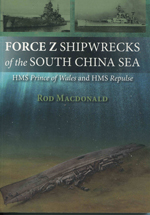
Force Z Shipwrecks of the South China Sea
By Rod McDonald
Whittles; softback, 156 pages
Reviewed by Jack Aubrey
THE SHIPWRECKS of HMS Prince of Wales and HMS Repulse lie in relatively shallow water compared with the wrecks of HMAS Sydney and its opponent Kormoran. For many in Britain in WWII, the loss of the two British ships resonated throughout the community much as the loss of our own 645 brave sailors did with Australia’s sinking in 1941.
On 9 December 1941, both of these immense vessels – a battleship and a battlecruiser – were lost to overwhelming air attack off Malaya. Swarms of Japanese torpedo-bombers overwhelmed their defences and smashed them with their air-launched weapons, which were often in the water racing towards the RN ships in groups and from different directions. The warships fought well, but their anti-aircraft defences were simply inadequate. Prince of Wales and Repulse sank quickly, taking with them hundreds of their crews.
Force Z Shipwrecks of the South China Sea is an interesting book. It is not a minute recounting of the loss of the two ships, nor an analysis of the command decisions that sent them to their doom. Rather, it is a discussion of their technical design; some chapters devoted to the background of their loss, and then at the end, sections dealing with the wrecks as they are today, and what they can tell us about the physical aspects of the battle.
As such, if you know the story of these two vessels well already – and many readers of Headmark will do so – then you will skip over the first sections, although they are well written. The story of how the design of the two vessels came to be will hold such readers’ interests more. In particular, the textual wreck descriptions and colour photographs of the sites at the end of the work are quite fascinating. They are well shot, with enough light and detail to ponder over what exactly caused such damage, and various ancillary effects. There are labelled graphics which render assistance. For anyone who has studied the works of analysis dealing with Bismarck and Titanic this is familiar territory.
The rest of the book is well illustrated, and there is a good bibliography. Recommended.



